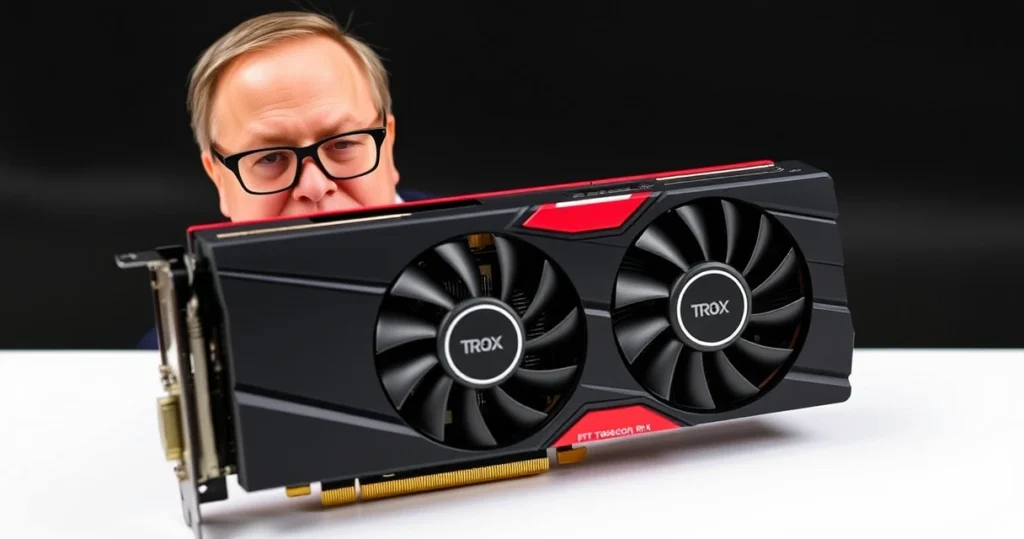In a world where technology evolves at an astonishing pace, it might come as a surprise that one of the most influential figures in the open-source community, Linus Torvalds, continues to rely on a GPU from 2017—the Radeon RX 580—for his Linux development work. The choice of hardware is particularly noteworthy given that Torvalds is known for pushing the boundaries of what is possible within the Linux kernel. This article explores the implications of his choice, the performance of the Radeon RX 580, and what this means for Linux development as a whole.

The Radeon RX 580, released in April 2017, was a mid-range graphics card that quickly gained popularity among gamers and developers alike. With the ability to handle modern gaming and graphics tasks, it remains a viable option even as new generations of GPUs flood the market. Torvalds’ continued use of this GPU raises questions about its longevity, performance, and the evolving needs of developers in the Linux community.
Understanding Linus Torvalds’ Choice
Linus Torvalds, the creator of the Linux kernel, has always been an advocate for practicality and efficiency. His decision to stick with the Radeon RX 580 is likely rooted in several factors, including performance, stability, and a preference for tried-and-true technology over the latest trends. By examining these elements, we can gain insight into his philosophy regarding hardware in development environments.
Performance Metrics of Radeon RX 580
While the Radeon RX 580 may not be the latest and greatest GPU on the market, it still offers impressive performance metrics that make it suitable for Linux development. Here are some of its key specifications:
- GPU Architecture: Polaris 20
- Stream Processors: 2,304
- Base Clock: 1,257 MHz
- Boost Clock: 1,340 MHz
- Memory: 8GB GDDR5
- Memory Interface: 256-bit
These specifications allow the RX 580 to handle various development tasks, including compiling code and running simulations, without significant bottlenecks. This performance is particularly useful for someone like Torvalds, who is continuously working on the intricacies of the Linux kernel.
Stability and Compatibility with Linux
Another reason Torvalds sticks with the Radeon RX 580 is the card’s stability and compatibility with Linux. AMD has made significant strides in its Linux driver support over the years, ensuring that the RX 580 works seamlessly with the kernel. This compatibility is crucial for developers who require a reliable environment for testing and development.
Moreover, the open-source nature of AMD’s drivers allows for a more tailored experience, enabling Torvalds and other developers to make adjustments as needed. This blend of performance and stability makes the Radeon RX 580 a fitting choice for Linux kernel development.
The Cost-Effectiveness of Older GPUs
As technology advances, older GPUs often become more affordable, making them an attractive option for developers on a budget. The Radeon RX 580 is no exception and can often be found at reduced prices compared to newer models. By choosing to use an older GPU, Torvalds not only saves money but also encourages developers to consider cost-effective alternatives that still deliver satisfactory performance.
Encouraging Sustainability
Sticking with older hardware aligns with the growing trend of sustainability in technology. By using a GPU that is still capable of handling development tasks, Torvalds promotes the idea of maximizing the lifespan of existing technology. This perspective is increasingly important as the tech industry grapples with environmental concerns related to e-waste and resource consumption.
Implications for the Future of Linux Development
Torvalds’ choice to continue using the Radeon RX 580 has broader implications for the Linux development community. It serves as a reminder that cutting-edge technology is not always necessary to achieve exceptional results in software development. Here are some key points to consider:
- Performance vs. Requirements: Developers should evaluate their actual performance needs rather than simply chasing the latest hardware.
- Community Support: Opting for hardware with strong community support can lead to better development experiences.
- Cost-Effectiveness: Investing in older, proven technology can yield significant savings while still meeting performance demands.
- Sustainability: Embracing older hardware promotes a more sustainable approach to technology use.
Frequently Asked Questions (FAQ)
1. Why does Linus Torvalds use the Radeon RX 580?
Linus Torvalds continues to use the Radeon RX 580 for its solid performance, stability, and compatibility with Linux, making it suitable for his development work.
2. How does the Radeon RX 580 perform for Linux development?
The Radeon RX 580 performs well for Linux development tasks, such as compiling code and running simulations, thanks to its robust specifications and efficient drivers.
3. Is the Radeon RX 580 still relevant in 2023?
Yes, the Radeon RX 580 remains relevant in 2023 for many development tasks, particularly for those who do not require the latest GPU capabilities.
4. What are the advantages of using older hardware for development?
Using older hardware can be cost-effective, promote sustainability, and still meet the performance needs of many development tasks.
5. How has AMD improved Linux support for its GPUs?
AMD has significantly improved its Linux driver support over the years, providing open-source drivers that enhance stability and compatibility for various AMD GPUs, including the RX 580.
Conclusion
Linus Torvalds’ choice to stick with the 2017 Radeon RX 580 for Linux development is a testament to the card’s enduring performance, reliability, and cost-effectiveness. As the technology landscape continues to evolve, Torvalds serves as a reminder that newer isn’t always better, and practical choices can lead to successful outcomes. His continued use of this GPU not only highlights its capabilities but also encourages developers to consider sustainable and economical options in their hardware choices. As more developers recognize the value of older but reliable technology, the Linux community can continue to thrive, driven by innovation and efficiency.
📰 Original Source
Este artigo foi baseado em informações de: https://tecnoblog.net/noticias/linus-torvalds-ainda-usa-uma-velha-gpu-rx-580-para-trabalhar/



